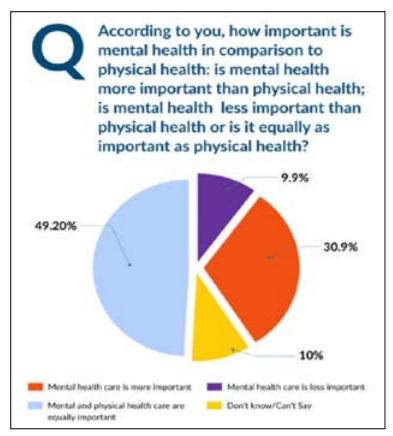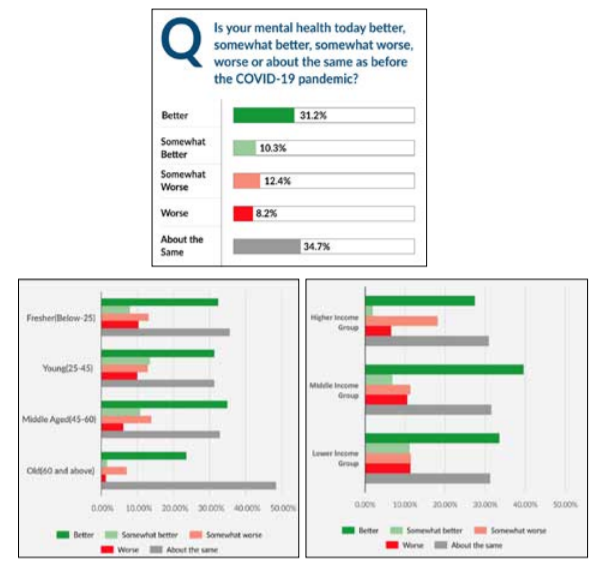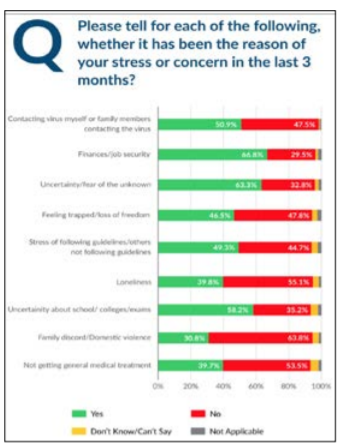
As the world continues to deal with the financial, economic and social impact of the Covid-19 pandemic, households are struggling with the mental and emotional impact of job losses, income cuts, loss of loved ones, loneliness, and uncertainty about their future. Undoubtedly, along with its physical dangers, the pandemic has impacted the mental health of billions of people globally, many of whom are still under lockdown.
Team CVoter conducted a series of surveys in June 2020 to capture the effect of the Covid-19 pandemic and the consequent lockdown on the mental health of Indians across the country. We break these numbers down to show you the changes in overall mental health of Indians across the country. These include the main reasons for increased stress and anxiety amongst people in the last three months; loneliness, uncertainty, loss of income, and fear of domestic violence are some of these reasons. The surveys also look at the steps people are taking to cope with their changed circumstances.
How important is mental health?

First, in order to understand the importance placed on mental health in India, respondents were asked whether they think mental health is more, equally or less important than physical health. Almost 50% of respondents said they think both are equally important, while another 30.9% said they think mental health is more important than physical health.
How has the pandemic affected mental health?

Overall, around 20.6% of Indians reported that their mental health has worsened during Covid-19. At the same time, around 34.7% of respondents also reported having no change in their mental health now as compared to before the pandemic. These figures are consistent globally, as research conducted by the firm SSRS showcased that a third of people in the United States said they experienced stress, anxiety or sadness that was difficult to cope with alone since the outbreak of Covid-19. Similarly, around 25% of respondents in Canada, the UK and France also said they had suffered mental health problems as a result of the pandemic.
The levels of decline in mental health also varied by age, income and gender. Around 25.1% of females reported a decline in their mental health while only 16.4% of males reported the same. Those in the youngest age group (below 25) reported the highest decline (23.4%) while those in the oldest age group (60 and above) reported the lowest decline (8.3%). 22.5% of respondents in the lower-income group reported a decline, followed by 20% in the higher income group. Those in the middle-income group reported the lowest decline in their mental health (18.1%).
Has Covid-19 led to rise in domestic violence?
As countries across the world began to go into lockdown to help protect people from infection, a “shadow pandemic”, as stated by the United Nations, began to unfold in homes globally as women who had been victims of domestic abuse were trapped at home with their abusers. Reports of domestic violence abuse have increased in India and globally as households struggle with the additional strains of the pandemic. These include security, health and income struggles, in addition to being in the confines of a crowded home with limited or no access to services and reduced peer and family support.
According to the United Nations, reports of domestic violence abuse, which are majorly under-reported globally, have increased by around 25%. In India, data from the National Commission of Women (NCW) in mid-April suggested an almost 100% increase in domestic violence during Lockdown 1.0. Additionally, in just eleven days during the start of India’s lockdown, the Childline India helpline received more than 92,000 calls (20–31 March) asking for protection from abuse and violence.
Similarly, in France, reports of domestic violence rose by 30% after the lockdown started, while in China reports nearly doubled during the lockdown, with 90% relating to the pandemic. In May 2020, a study conducted by the UNFPA highlighted that if the lockdown continued for another six months, cases of domestic violence could rise to 31 million globally.
Even before the Covid-19 lockdown, as per figures by the United Nations, less than 40% of women who experienced violence sought help of any sort. Add to that the restrictions of being inside your own home, trapped with your abuser, with no network of support from friends and family, and reduced access to helplines and other services, women globally are the most vulnerable during this pandemic. Even as lockdowns are being relaxed in countries globally, it is important to remember that often personal crises such as those caused by the pandemic, including job loss and major financial setbacks can often aggravate abusers further.
What are the primary causes of stress and anxiety?

The most commonly cited cause of stress or concern for Indians over the last three months was finances and job security followed by uncertainty and fear of the unknown. Other major causes of stress included uncertainty about school or college exams (58.2%), fear of contracting the virus (50.9%) and the stress of following the guidelines (49.3%).
The main causes of concern varied significantly by age groups. For all age-groups, except for those over 60, finances and job security were the most commonly cited reasons for concern. The older age group (60 above) cited uncertainty and fear of the unknown as their most common cause of concern for the last three months (48%).
For females, the most commonly cited cause of concern/stress was finances/job security (70.1%), followed by uncertainty/fear of the unknown (59.9%) and uncertainty about school/college (53.3%). On the other hand, for males, the most commonly cited cause of concern/ stress was uncertainty/fear of the unknown (66.5%), finances/job security (63.7%) followed by uncertainty about school/college (62.8%). In addition to this, 30.9% of females and 30.7% of males cited family discord or domestic violence as one of the main causes of stress during the lockdown.
What steps are we taking to improve mental health?

Overall, the most common method cited by respondents to improve their mental health is talking about it with family (53.9%), followed by keeping themselves busy with hobbies (44.1%), while the least common is seeking medical help (5.7%). When comparing these figures across demographics we observe that those in older age groups are much less likely to take steps towards improving their mental health. The percentage of people in older age groups (60 and above) undertaking methods regularly to improve their mental health over the last three months is much lower than those in other age groups.
Additionally, we observe that for both males and females, the least commonly cited method to improve their mental health is seeking medical help. As per data by the World Health Organization, there is a wide “treatment gap” for all mental health disorders in India, whereby only 10% of patients in the country get treated.
This could be due to the shortage of mental health professionals in the country (three psychiatrists for every one million people), the mere 0.06% of the healthcare budget dedicated to mental healthcare, lack of awareness and taboo around mental health, or the fact that for roughly 40% of Indians who have medical insurance, mental health is usually not covered in the same.
As Indians continue to battle the pandemic, it is important to remember to offer help and reach out to those who you think might be struggling from the impact of the lockdown and the crisis.
Footnote
All survey findings and projections are based on the Team CVoter Corona Tracker Mental Health survey waves 1-3 carried out in June 2020 among 18+ adults statewide, including every major demographic.
The data is weighted to the known demographic profile of every state, including age group, social group, income, region, gender and education levels. (Sample Size: 4,640)
Other Sources:
https://thewire.in/health/socialfactors-behind-the-stigma-that-surrounds-mental-health-in-india
https://www.livemint.com/Money/ YopMGGZH7w65WTTxgPLoSK/56- Indians-still-dont-have-a-healthcover.html#:~:text=Of%20 the%20population%20with%20 health,government%20health%20 scheme%20(CGHS).
https://www.weforum.org/agenda/2020/08/how-to-protect-mentalhealth-during-coronavirus/
https://www.mohfw.gov.in/pdf/COVID19Final2020ForOnline9July2020. pdf